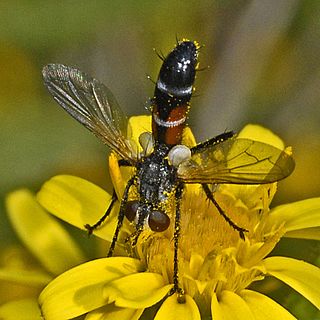
The Tachinidae are a large and variable family of true flies within the insect order Diptera, with more than 8,200 known species and many more to be discovered. Over 1,300 species have been described in North America alone. Insects in this family commonly are called tachinid flies or simply tachinids. As far as is known, they all are protelean parasitoids, or occasionally parasites, of arthropods, usually other insects. The family is known from many habitats in all zoogeographical regions and is especially diverse in South America.

Eriothrix rufomaculatus is a fly in the family Tachinidae.

Phasia hemiptera is a fly belonging to the family Tachinidae.

Pelatachina is a genus of flies in the family Tachinidae.

Tachina fera is a species of fly in the genus Tachina of the family Tachinidae. It was first described by Carl Linnaeus in 1761.

Conops quadrifasciatus, the yellow-banded conops, is a species of fly from the genus Conops in the family Conopidae.

Prosena siberita is a species of fly in the family Tachinidae.

Phasia obesa is a species of 'parasitic flies' belonging to the family Tachinidae subfamily Phasiinae.

Compsilura concinnata is a parasitoid native to Europe that was introduced to North America in 1906 to control the population of an exotic forest, univoltine, spongy moth named Lymantria dispar. It is an endoparasitoid of larvae and lives with its host for most of its life. Eventually the parasitoid ends up killing the host and occasionally eating it. It attacks over 200 host species, mainly insects from the Orders: Coleoptera, Lepidoptera and Hymenoptera. Since this parasite has the ability to attack many different types of hosts, the organism has spilled over from the intended forest systems into other areas, like agricultural fields, affecting cabbage pests including the cabbage looper (Trichoplusia); the cabbage worm ; and even other invasive species such as the brown-tail moth. However, it also attacks native, non-pest insects such as the Cecropia moth and American moon moth.
Zosteromeigenia mima is a species of fly in the family Tachinidae and the sole representative of the genus Zosteromeigenia. Like the vast majority of tachinid flies, Z. mima is expected to be a parasitoid of other arthropods, likely the larvae of Lepidoptera, however few or no host records exist.

Cylindromyia interrupta is a species of fly in the family Tachinidae.

Cylindromyia brassicaria is a species of fly in the family Tachinidae.

Lophosia fasciata is a European species of fly in the family Tachinidae. It is the type species of the genus Lophosia.
Clytiomya continua is a European species of fly in the family Tachinidae. Hosts for the parasitoid larvae include Coreus marginatus orientalis, Eurygaster testudinaria, Eurydema gebleri, Eurydema dominulus, Graphosoma rubrolineatum, Homalogonia confusa, and Dolycoris baccarum. Larval development takes six to eleven days.

Phasia pusilla is a European species of fly in the family Tachinidae. Its larval hosts include species in the families Lygaeidae, Cydnidae, and Anthocoridae.

Zophomyia temula is a species of fly in the family Tachinidae.

Nemoraeini is a tribe of flies in the family Tachinidae.

Siphona geniculata is a Palearctic species of fly in the family Tachinidae.

Nemorilla floralis is a species of tachinid fly.

Dinera carinifrons is a species of fly in the family Tachinidae. It is found in Europe and Asia.


















